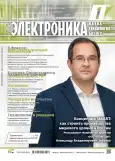State-of-the-art quartz and rubidium oscillators
- Authors: Ivanov Y.1
-
Affiliations:
- АО «Морион»
- Issue: No 1 (2024)
- Pages: 106-113
- Section: Electronic components
- URL: https://journals.eco-vector.com/1992-4178/article/view/628914
- DOI: https://doi.org/10.22184/1992-4178.2024.232.1.106.113
- ID: 628914
Cite item
Abstract
Rubidium or precision quartz oscillators are most often used as reference frequency sources in telecommunications equipment. Each of these types of generators has its own advantages and disadvantages, but their stability may be quite comparable in the end.
Full Text
About the authors
Yu. Ivanov
АО «Морион»
Author for correspondence.
Email: Ivanov-UA@morion.com.ru
старший инженер-разработчик
Russian FederationReferences
- Kotyukov A., Ivanov Y., Nikonov A. Precise Frequency Sources Meeting the 5G Holdover Time Interval Error Requirement // Microwave journal. May 2018.
- Иванов Ю.А. О подходе к оценке временной ошибки при применении прецизионных кварцевых генераторов (КГ) в новейших телекоммуникационных системах // Доклады VIII международного симпозиума «Метрология времени и пространства». Менделеево, ФГУП «ВНИИФТРИ». 2017. С. 30–35.
- Иванов Ю.А., Никонов А.Г., Котюков А.В. Использование прецизионных генераторов в аппаратуре стандарта 5G // Современная Электроника. 2019. №3. С. 52–55.
Supplementary files
Supplementary Files
Action
1.
JATS XML
Download (21KB)
Download (8KB)
4.
Fig. 3. Dependence of typical time of output of precision generators to different standards on daily aging on the time of being in the switched-off state
Download (13KB)
Download (10KB)
Download (16KB)
Download (11KB)
Download (10KB)
Download (22KB)
Download (23KB)
Download (38KB)
Download (21KB)
Download (40KB)
Download (13KB)
15.
Fig. 14. Frequency drift (left) and induced time error (right) with linear aging compensation taken into account
Download (24KB)
Download (43KB)























